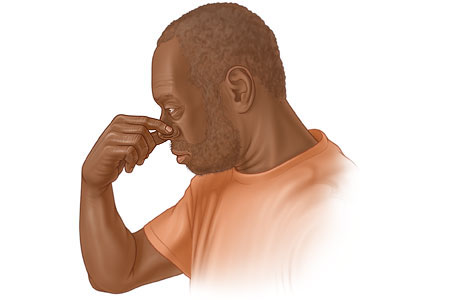Our Health Library information does not replace the advice of a doctor. Please be advised that this information is made available to assist our patients to learn more about their health. Our providers may not see and/or treat all topics found herein.
Topic Contents
Stopping a Nosebleed
Overview
Most nosebleeds aren't serious. They usually can be stopped with home treatment. Most nosebleeds occur in the front of the nose and involve only one nostril. Some blood may drain down the back of the nose into the throat.
A less common but more serious type of nosebleed starts in the back of the nose. It often involves both nostrils. Large amounts of blood may run down the back of the throat. You will need treatment from a doctor to control bleeding from this type of nosebleed.
Stopping a nosebleed

Follow these steps to stop a nosebleed.
- Gently blow your nose to clear any clots.
- Sit up straight and tip your head slightly forward.
Do not tilt your head back. This may cause blood to run down the back of your throat, and you may swallow it. Swallowed blood can irritate your stomach and cause vomiting. And vomiting may make the bleeding worse or cause it to start again. Spit out any blood that gathers in your mouth and throat rather than swallowing it.
- Use your thumb and forefinger to firmly pinch the soft part of your nose shut.
The nose consists of a hard, bony part and a softer part made of cartilage. Nosebleeds usually occur in the soft part of the nose.
Spraying the nose with a decongestant nasal spray like oxymetazoline (Afrin) before applying pressure may help stop a nosebleed. Be safe with medicines. Read and follow all instructions on the label.
You will have to breathe through your mouth.
- Keep pinching for at least 15 minutes.
Use a clock to time the 15 minutes. It can seem like a long time. Resist the urge to peek after a few minutes to see if your nose has stopped bleeding.
- Check to see if your nose is still bleeding after 15 minutes.
If it is, hold it for 10 to 15 more minutes. Most nosebleeds will stop after 10 to 20 minutes of direct pressure.
- Put a thin layer of a saline- or water-based nasal gel, such as NasoGel, or an antiseptic nasal cream inside your nose.
Do not blow your nose or put anything else inside your nose for several hours after the bleeding has stopped.
- Rest quietly for a few hours.
Preventing nosebleeds
The following tips may prevent a nosebleed from happening.
- Avoid forceful nose-blowing.
- Do not pick your nose.
- Avoid lifting or straining after a nosebleed.
- Keep your head elevated right after a nosebleed.
- Put a thin layer of nasal gel or cream inside your nose.
Use a saline- or water-based nasal gel, such as NasoGel, or an antiseptic nasal cream.
- Do not smoke, and avoid secondhand smoke.
Smoking can dry out your nose and increase your chance of a nosebleed. If you need help quitting, talk to your doctor about stop-smoking programs and medicines. These can increase your chances of quitting for good.
- Be careful with nonprescription antihistamines, decongestants, or medicated nasal sprays
Nosebleeds may develop in people who have colds or chronic allergy symptoms (postnasal drip, sneezing, or a runny, stuffy, or itchy nose) because nasal tissues become inflamed and irritated. Using medicines may relieve the symptoms, leading to less inflammation and irritation and fewer nosebleeds. But overuse of allergy medicines may lead to nosebleeds because of their overdrying side effects.
Related Information
Credits
Current as of: October 27, 2024
Author: Ignite Healthwise, LLC Staff
Clinical Review Board
All Ignite Healthwise, LLC education is reviewed by a team that includes physicians, nurses, advanced practitioners, registered dieticians, and other healthcare professionals.
Current as of: October 27, 2024
Author: Ignite Healthwise, LLC Staff
Clinical Review Board
All Ignite Healthwise, LLC education is reviewed by a team that includes physicians, nurses, advanced practitioners, registered dieticians, and other healthcare professionals.
This information does not replace the advice of a doctor. Ignite Healthwise, LLC disclaims any warranty or liability for your use of this information. Your use of this information means that you agree to the Terms of Use and Privacy Policy. Learn how we develop our content.
To learn more about Ignite Healthwise, LLC, visit webmdignite.com.
© 2024-2025 Ignite Healthwise, LLC.


